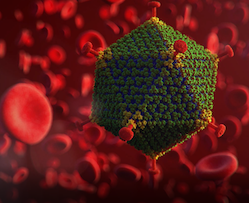People suffering from cancer want to do anything they can that is available to them as an option to try to overcome this ailment. Many opt for a holistic cancer treatment, as this type of treatment also takes into account their comfort and the fact that their body will be considerably affected by medications and chemotherapy. Others do both that and work with a naturopath to try to remain in the best physical health possible, specially with the unavoidable adverse effects of our current means of combating cancer. Scientists attempting to find a solution to this elusive and varied ailment are also trying to attack this problem from as many angles as possible and in doing so, have possibly found a somewhat out of the box solution that is currently still being developed and tested. Cancer researchers can claim to have devised “smart bombs.” What has been missing is the stealth bomber – a delivery system that can slip through the body’s radar defenses.
Oncolytic viruses, or viruses that preferentially kill cancer cells, have been discussed and tested for decades. An oncolytic virus against melanoma was approved by the FDA in 2015. But against metastatic cancers, they’ve always faced an overwhelming barrier: the human immune system, which quickly captures viruses injected into the blood and sends them to the liver, the body’s garbage disposal.
Researchers at Emory and Case Western Reserve have now circumvented that barrier. They’ve re-engineered human adenovirus, so that the virus is not easily caught by parts of the innate immune system.

A cryo-electron microscopy structure of the virus and its ability to eliminate disseminated tumors in mice were reported on November 25 in Science Translational Medicine.
“The innate immune system is quite efficient at sending viruses to the liver when they are delivered intravenously,” says lead author Dmitry Shayakhmetov, PhD. “For this reason, most oncolytic viruses are delivered directly into the tumor, without affecting metastases. In contrast, we think it will be possible to deliver our modified virus systemically at doses high enough to suppress tumor growth — without triggering life-threatening systemic toxicities.”





